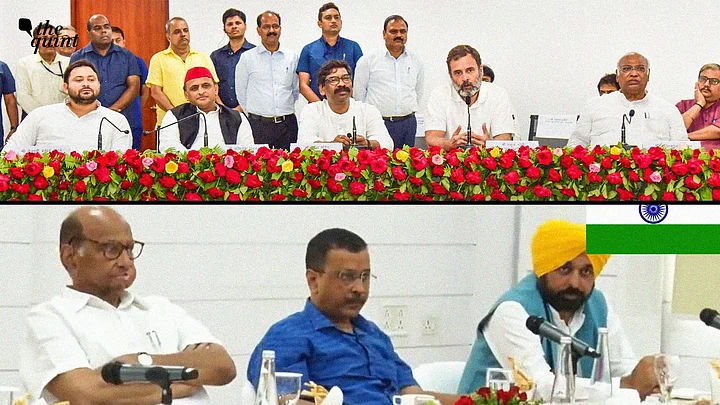As part of the efforts to unite the Opposition for the 2024 Lok Sabha elections, the second meeting of key non-NDA parties will be taking place in Bengaluru on 17 and 18 July. The first meeting had taken place in Patna in June, hosted by Bihar chief minister Nitish Kumar.
Despite being the first meeting, the Patna huddle was successful in laying the groundwork for greater collaboration between Opposition parties. Can they keep up the momentum in Bengaluru?
Here are seven things that are likely to happen during the two day meet.
1. Expanded Guest List
The Patna meeting was attended by 32 leaders from 15 Opposition parties. The Bengaluru meet could see the participation of about 25 parties. Among the new attendees expected are:
Rashtriya Lok Dal and Krishna Patel-led Apna Dal from Uttar Pradesh
Tamil Nadu parties MMK, MDMK, KDMK and VCK,
Congress' allies from Kerala - IUML, Kerala Congress (Joseph) and RSP
Left Front allies Forward Bloc and Kerala Congress (Mani)
While the expanded guest list may make for good optics, it isn't of much political significance as all these parties have anyway been firmly in the anti-BJP camp.
2. Focus on Monsoon Session
Since the meeting is taking place just on the eve of the Monsoon Session of Parliament, there is likely to be some focus on better coordination between political parties during the session.
In particular, the AAP is likely to bring up the need for a plan to counter the Centre's ordinance curtailing the powers of the elected government in Delhi.
While the Bill is likely to pass in the Lok Sabha, a united Opposition could give the government a headache in the Rajya Sabha. If the parties attending the Bengaluru meet combine their numbers, the NDA would have to rely on fence-sitting parties like the YSRCP and BJD.
The other Parliament-related issue that could come up is the possibility of the Modi government bringing a Uniform Civil Code.
The Opposition parties are not united on this issue. In all probability, the parties may agree to disagree on this issue and not make it a deal-breaker.
3. Convenorship Question
With the parties likely to build on the discussions that took place in Patna, the Opposition may need to formally choose a convenor for better coordination in future.
Whether this would be a formal position like the NDA convenor or UPA convenor, or a pointsperson without a clear nomenclature remains to be seen.
If at all such a position comes up for discussion, Bihar CM Nitish Kumar is no doubt the frontrunner as the Opposition meetings are his initiatve. However, the presence of former Congress president Sonia Gandhi has given rise to speculation that if a formal position is announced, the Congress could push for her name.
Then there's also Sharad Pawar, who enjoys goodwill across parties.
4. Seat-Sharing Discussions
After the Patna meeting, the parties announced that they would talk about seat-sharing at the next meeting. Whether there is some progress on this front or not could be the make or break factor in the Bengaluru meeting.
In the 2019 Lok Sabha elections, the Opposition parties had already united as much as possible in states like Tamil Nadu and Jharkhand. Then alliances already exist in Bihar and Maharashtra and chalking out seat sharing is the only question.
However, there are many states where Opposition parties attending these meetings, are competing among themselves - SP vs Congress in Uttar Pradesh, Congress vs AAP in Punjab and Delhi, Trinamool Congress vs Left and Congress in West Bengal and Left vs Congress in Kerala.
Now, the Opposition can live with friendly or even not-so-friendly fights in West Bengal, Kerala, Delhi and Punjab. However, Uttar Pradesh is an important state and a pre-poll alliance is essential if the Opposition has to have any chance of taking on the BJP.
UP may be the test case for Opposition unity.
5. Focus on Sharad Pawar and Sonia Gandhi
A great deal of focus at the Bengaluru meeting would be on NCP chief Sharad Pawar and former Congress president Sonia Gandhi, but for different reasons.
This would be the first national meeting of this scale following the NCP's split engineered by Pawar's nephew Ajit Pawar. What Pawar says at the meeting regarding the split, will be important to note.
Sonia Gandhi's presence at the meeting is also significant. Her remarks and interactions with different Opposition leaders could set the tone for the Congress' approach towards these parties. Particularly important would be how Sonia Gandhi interacts with leaders of parties the Congress is competing with - TMC, AAP and SP.
6. AAP-Congress Equation
A great deal of media attention during the Patna meet went to AAP's attacks on the Congress for not making its stand clear on the Delhi ordinance. However, now with the Congress announcing unequivocal opposition to the Centre's ordinance, it creates space for new rules of engagement between the two parties.
Congress sees AAP as a long term threat and there is considerable bad blood between the AAP and the Congress units in Punjab and Delhi.
However, the Bengaluru meeting would give an indication on whether the parties can cooperate at the national level even while being rivals in these two states, a bit like the Congress' equation with the TMC, SP or the Left.
7. Timeline of Rallies, Protests and Meetings
The leaders of the parties attending the meeting are likely to decide on a timeline of events - such as joint protests and rallies targeting the NDA government. They would also discuss where the next Opposition meeting will take place and what the agenda would be.
(At The Quint, we question everything. Play an active role in shaping our journalism by becoming a member today.)
